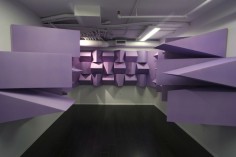Jacqueline Kiyomi Gordon

source: empacrpiedu
Jacqueline Kiyomi Gordon is a visual and sound artist who currently resides in Los Angeles. Her work integrates audio technologies into sculptural forms to question relationships of affect to an environment. She received a BFA from the San Francisco Art Institute (2004) and an MFA from Stanford University (2011) where her research focused on the history of communications technology and the physiological and psychophysical effects of music and sound on the body. Gordon has had solo shows at Yerba Buena Center for the Arts (2014), Pro Arts Gallery (2013, Oakland), Eli Ridgway Gallery (2012, San Francisco), and Queens Nails (2009, San Francisco), and she has been included in exhibitions at the Institute of Contemporary Art (London, UK), di Rosa (Napa, CA), and Machine Project (Los Angeles, CA). Gordon has received numerous awards, including the 2011 Joan Mitchell Foundation MFA Award, a Center for Cultural Innovation Grant (2011), and a San Francisco Arts Commission Cultural Equity Grant (2009). She has participated in artist residencies at Skowhegan School of Drawing and Painting (2011), Bemis Center for Contemporary Art (2008) and Djerassi Resident Artists Program (2013).
For the past 6 years, Gordon has been a member of the music and performance collective, 0th, whose performances include venues such as the Berkeley Art Museum (2011), the San Francisco Electronic Music Festival (2011), and Southern Exposure (2010). She has recently been developing a new performance with sound artist, Leatitia Sonami. They have performed together at Yerba Center for the Arts (San Francisco, 2011) and SOMArts (San Francisco, 2012).
.
.
.
.
.
.
.
source: e-flux
Los Angeles-based artist Jacqueline Kiyomi Gordon works in sound, installation, and sculpture. Her work is often devised around audio and spatial feedback systems that manipulate the visitor’s awareness of sound and space, incorporating the physical and sonic qualities of surrounding architecture to engage the viewer’s senses. Gordon investigates sonic and architectural applications of cybernetic systems in the 20th and 21st centuries to technological design, from anechoic chambers to the military’s use of Long Range Acoustic Device (LRAD) speakers. Reverse-engineering those implements of social control, the dissonant spaces she creates uncover how such systems regulate human subjectivity, mobility, and perception.
Commissioned by YBCA, Gordon’s new installation—part of her solo exhibition It Only Happens All of the Time—is an immersive sonic experience that emphasizes the primacy of the embodied experience; one that encourages the visitor to navigate the space through a mode of listening that is both felt and heard. Gordon explores sound’s ability to establish different levels of intimacy, and the exhibition’s title points towards the ubiquitous presence of sound in that process, whether it exists at the periphery or center of our awareness. The installation’s sound-absorbing walls reference the design of anechoic chambers found in military and scientific testing facilities, which insulate and absorb sound reflections. In contrast to the walls of the installation, which gestures towards a calculated experience, the sculpture Love Seat situated within this contained environment suggests another, more emancipated, arrangement. Surrounded by a multi-channel speaker system distributed throughout the gallery, Love Seat encourages visitors to sit and share in a listening experience with others, while maintaining a physical separation. Fostering an exchange between visitors that wavers between proximity and distance, Love Seat parallels how we listen together.
Gordon’s other works for the exhibition echo a similar concept—sound as experienced within the body becomes a way to feel with others, and to experience the mechanisms of built space through non-visual means. Her film Everyone Will Be Here Now But Me documents a site-specific sound environment created within the empty offices of the Los Angeles Food Center. It follows visitors as they explore sound installations distributed throughout the building, with the option to listen through binaural microphones that captured the 3D stereo sound of the space. The suspended figures in Gordon’s new series of drawings and watercolors Filter Resonance B more subtly signal the body; wire-like lines protrude and drift through these organ-like forms, a reference to the potential for connectivity. Gordon imagines that the drawings represent actual filters, which isolate information, and their presentation is meant to evoke the interfaces of audio filters in music software, which allow the user to directly regulate reverb, equalization, and so on by manipulating graphic elements. Much like the show itself, these strange configurations invite reflection on the many ways the body is instrumentalized through technology.
Control: Technology in Culture, curated by Ceci Moss, Assistant Curator of Visual Arts, is YBCA’s new series of exhibitions showcasing work by emerging and mid-career artists who examine the social, cultural, and experiential implications of technology. The series seeks to prompt timely questions about the profound and far-reaching influence of technology in our daily lives by focusing on artists whose work spans a multitude of disciplines and relates to a diverse set of issues, including architecture, acoustics, psychology, labor, consumerism, the environment, and the military.
The term “control” refers to philosopher Gilles Deleuze’s theory that, as a result of the ever-increasing role of information technology, Michel Foucault’s “disciplinary society” of the 20th century has given way to a “control society” in the 21st century. In contrast to discipline, which molds the individual through confinement in factories, prisons, and schools, control is diffuse, adaptable, and ubiquitous, modulating rather than molding the individual.

